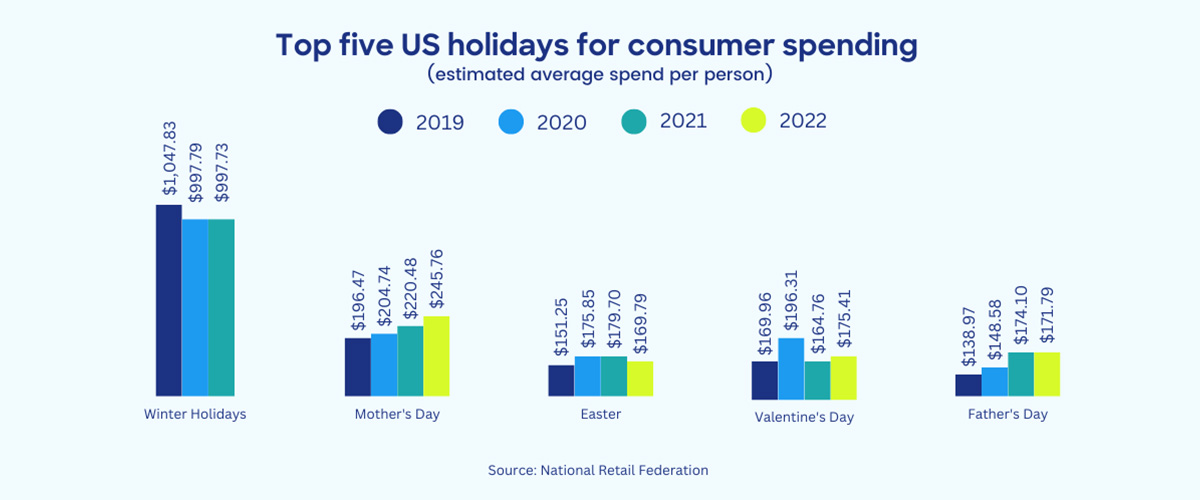Make a list, check it twice. Retail peak season is coming to town.
Holidays sales are expected to increase, albeit at a slower pace due to inflation. But ho ho ho! Prospects look bright for the e-commerce space.
It’s the most profitable time of the year
The winter holidays may be a bit far off, but if you are a retailer looking for opportunities to drive sales, you may want to prepare early for the busiest, most profitable time of the year.
In the U.S. alone, nearly 200 million people are expected to shop in-store and online during the five-day period between Thanksgiving and Cyber Monday.
Another 150 million people, meanwhile, are expected to do their last-minute shopping on the last weekend before Christmas.
And with this year’s holiday shopping season projected to bring in more than $1.4 trillion in sales, retailers are in a good position to meet or even exceed their revenue targets.
The inflation factor
While multiple studies already project growth in retail sales for the 2022 holiday season, inflation is expected to slow it down.
Research by London-based professional services firm Deloitte projects holiday retail sales growth between four and six percent, slower than last year’s 15%, because of surging inflation.
It is a different story, though, with the e-commerce market, which is expected to increase by 14 percent in sales, compared to 8.4 percent last year, which amounts to around $264 billion.
Analysts from Deloitte said people will be looking to spend more time shopping on e-commerce sites and online marketplaces where they believe they can get the best deals while saving on travel time and costs.
Shopping online gives consumers the chance to scour hundreds of products from various sellers across the country, or even the world, to find the best gifts within their budget.
Taking advantage of the holiday season
While the holiday season offers great opportunities for retailers of all types to bring in more customers, it does require extensive preparation.
It’s easy for retailers to get overwhelmed by the sudden influx of customers, especially in the e-commerce space, but proper planning and management can help the organization stay on top of things.
Here are some ways to optimise your retail businesses for the year-end holidays and other peak shopping seasons.
Know your traffic
The first step in preparing for the holiday shopping season is knowing when it happens and how the market and customers respond to it.
Data points you need to consider include the number of customers that browse and purchase at specific times, what store channels they engage with, and the average basket size per customer.
If the numbers are consistent, this can be used as a baseline to predict both short and long-term traffic, allowing you to prepare staffing and inventory accordingly.
Some retailers even go as far as to use AI software for more accurate predictions of customer traffic and trends.
Plan and hire staff early
Once you have a clear picture of store traffic and customer behavior and preferences, it’s time to staff up. Determine a headcount and specify the roles they need to fill.
This should be done as early as possible to ensure that the organization has the essential resources and support in place before the shopping rush begins.
Inventory and logistics staff, for example, take significant time and effort to train in ensuring smooth order fulfilment and shipping.
These days, shoppers are extra keen on product specs, pricing, and discounts. So, you may need to set up a dedicated customer service team for real-time query response.
Hiring workers early also gives you a better chance of landing the best talent before other companies do. Remember, your business isn’t the only one looking for support.
Having a dedicated outsourcing partner to find, hire, and manage quality talent can be the X factor that will help you meet the surging demands of the holiday season.
You can start looking at top outsourcing destinations like the Philippines when looking for a variety of roles with top-tier global experience and seamless adaptability.
There are also hidden gems in nearshoring markets. Companies can work with remote teams within the same time zone, like Colombia for U.S. companies and Sri Lanka for U.K. firms.
There are plenty of options in outsourcing talent, but the best providers are those that allow you to have full control over your outsourced team.
Balance inventory according to demand
Predicting traffic through a sales or consumer forecast can help businesses anticipate how much inventory is needed.
Using this information, strategise with your team on how to optimize inventory across all channels and locations based on customer demand.
For example, identify the type of products that are best showcased in physical stores, on the store’s main website, online marketplaces, social media, and other channels.
If the business has multiple stores, check if there is enough of each product per location to prevent costly split orders. In-demand inventory can also be masked to help prevent unfulfilled orders.
Keeping all store channels and locations stocked with the right amount of inventory helps ensure high fulfillment rates and customer satisfaction.
Ensure your IT infrastructure can handle additional traffic
Are your digital assets strong enough to handle the influx of queries and orders? Are there glitches and slow loading times that remain unresolved within your system? Checking your capacity to handle additional traffic and manage the customer experience should be a priority.
The store’s order management system (OMS) should be capable of handling the sudden influx of orders without affecting processing times.
Online storefronts should also have reasonable loading times and be optimized for responsive, mobile-friendly design.
This is crucial considering that 3 out of 4 purchases made during Black Friday and Cyber Monday were done through mobile devices. So, making it easy for users to browse and purchase from your store through their devices is non-negotiable.
Offer hassle-free returns
Return orders are inevitable in retail. These can affect conversion rates, profit margins and ultimately, your bottomline.
But even more important to your business is how you handle these return orders. So, creating a seamless returns process is key.
In a recent consumer report from Narvar, 96% of shoppers said they would shop with a retailer again if they had an easy experience returning an item.
This can usually be solved by making the returns process short and painless for the customer at no extra cost.
Even something as simple as providing customers with pre-printed labels for seamless returns has a significant effect in improving customer satisfaction.
Planning for retail in the holiday season can be challenging. But, if done correctly, it can build positive customer sentiment and lead to long-term growth for the company.
So, sit down with your team, discuss your strategy, and see how the above mentioned tips can be integrated into your plans. Soon, your business will be ready for the most profitable time of the year.


















